Use 'Print preview' to check the number of pages and printer settings.
Print functionality varies between browsers.
Printable page generated Friday, 19 April 2024, 1:41 AM
Study Session 4 Liquid Wastes: Sources, Types and Characteristics
Introduction
You were introduced to the main types of liquid waste in Study Session 1. This study session is the first of three that builds on that introduction and describes liquid wastes in more detail. We begin with a closer look at the sources and characteristics of liquid wastes. Study Session 5 focuses on the different types of latrine available for urban areas in Ethiopia. In Study Session 6 you will learn about the management and treatment of liquid wastes.
The type and composition of liquid waste depends on the source. In urban areas, the main sources are households, commercial establishments and industries. We need accurate information on the characteristics of liquid wastes in order to establish proper waste management processes to deal with them. In this study session you will learn about the main sources of liquid wastes and about different ways of characterising them. We also briefly describe some of the laboratory tests used to analyse liquid waste. The session ends with some specific examples of liquid wastes from industry.
Learning Outcomes for Study Session 4
When you have studied this session, you should be able to:
4.1 Define and use correctly all of the key words printed in bold. (SAQ 4.1)
4.2 Identify the main sources of liquid wastes and outline the differences between them. (SAQ 4.2)
4.3 Describe the characteristics of liquid wastes and give examples of tests used in their analysis. (SAQs 4.2 and 4.3)
4.4 Identify the main sources of industrial liquid waste in Ethiopia and outline the characteristics of the wastewaters they produce. (SAQ 4.4)
4.1 Sources of liquid waste
Liquid waste was defined in Study Session 1 as any waste in liquid form. The composition of liquid waste, also known as wastewater, is highly varied and depends principally on its source. In towns and cities, the three main sources are residential, commercial and industrial areas.
4.1.1 Liquid wastes from residential areas
List three liquid wastes from your daily life.
I’m sure you thought of several. Examples include the wastewaters from washing your face in the morning, from washing clothes, from taking a shower and from washing dishes. You may also have mentioned human bodily waste, which is also classified as liquid waste.
In urban areas, the liquid wastes from residential areas are often referred to as domestic wastewaters. These wastewaters come from our day-to-day living and include those from food preparation, washing, bathing and toilet usage. As you read in Study Session 1, different terms are used to describe wastewater from these various domestic sources.
What is the difference between blackwater, greywater and sullage?
Blackwater is wastewater that contains human excreta (faeces and/or urine). Greywater is wastewater from activities such as washing and food preparation and does not contain excreta. Sullage is another name for greywater.
Blackwater and greywater are produced from domestic dwellings with access to a piped water supply and also from business premises and the various institutions, such as schools and health centres, found in residential areas. The term sewage is used to describe a combination of all these types of liquid waste, frequently also with surface run-off.
In many towns and cities in the world, sewage is collected in underground sewers that carry the effluents to a sewage treatment works (Figure 4.1). (Effluent is another term for wastewater that flows out from a source.) At the treatment works, the sewage is cleaned by various physical and biological processes before being discharged into a river or lake. It may be possible to reuse the treated water, typically for irrigation. (Sewage treatment is described in Study Session 6.)

The quantity and type of liquid waste generated in a residential area depends on several factors, such as population size, standard of living, rate of water consumption, habits of the people and the climate. It also depends on the number and type of institutions such as schools and health centres in the area.
4.1.2 Liquid wastes from commercial areas
The wastewaters from commercial areas (Figure 4.2) – comprising business establishments, shops, open market places, restaurants and cafes – will mostly resemble those from households. This is because only human-related activities are undertaken in such areas, as opposed to other activities such as industrial production. Effluent from restaurants and cafes may contain high levels of oil from cooking processes but this can be overcome by using a grease trap (Figure 4.3) in their outlet pipes. A grease trap consists of a small tank or chamber which slows the speed of effluent flow. In the grease trap, fats, oils and grease float to the top of the wastewater and form a layer of scum that is contained within the tank. This can then be removed and disposed of as solid waste. Relatively clean water exits from the grease trap for disposal.
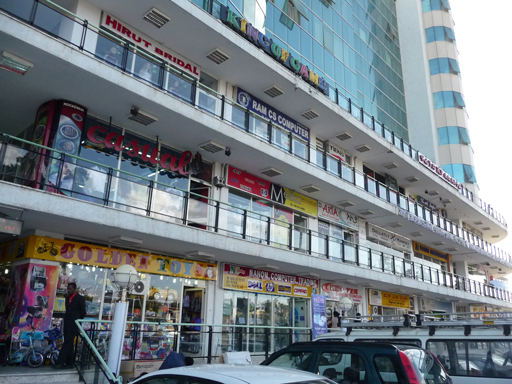
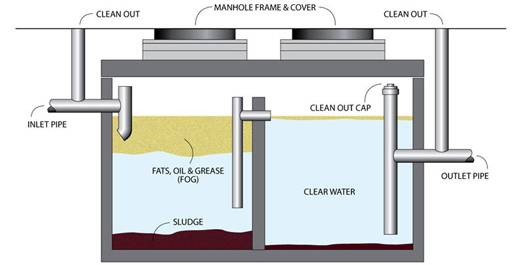
The quantity of wastewater generated per person in a commercial area will be less than it would be at home because the only time spent there is during the working day, and so activities such as bathing are not usually undertaken at these establishments.
4.1.3 Liquid wastes from industrial areas
In industrial areas liquid wastes are generated by processing or manufacturing industries and service industries, such as car repair shops. The type of industry determines the composition of the waste. The wastewaters from facilities that make food products will not be harmful to humans, but those from other industries may contain a variety of chemical compounds, some of which may be hazardous (and therefore potentially harmful). Industrial wastewaters which contain hazardous substances must be treated, and the substances removed before the wastewater is discharged to the environment. We will consider some specific examples of industrial wastes in Section 4.3.
The presence of hazardous materials is one way in which industrial wastewaters are often different from domestic wastewaters. Another difference is that the flow rate can vary dramatically in some industries, for example, where production rates vary with the season, such as in the processing of certain food crops.
4.1.4 Stormwater
Although not a form of liquid waste in the same way as wastes from residential, commercial and industrial areas, stormwater is also a form of wastewater. Stormwater can be contaminated with many different types of pollutant such as faecal matter, soil, rubber from vehicle tyre wear, litter, and oil from vehicles. Many parts of Ethiopia are faced with large volumes of stormwater during the rainy season (Figure 4.4). Where there is a sewerage network (a system of sewers), stormwater may be channelled into the sewers, or it may flow into open ditches.
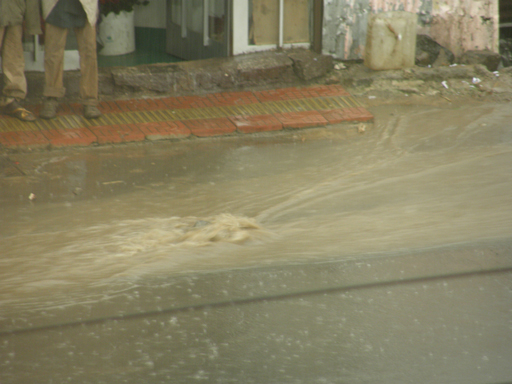
4.2 Characteristics of liquid wastes
Liquid wastes can be described according to their physical, chemical, and biological characteristics.
4.2.1 Physical characteristics of liquid wastes
Solids
Wastewaters may contain particles of solid material carried along in the flow. These may be settleable solids or suspended solids. Settleable solids sink to the bottom (settle out) when the speed of flow is reduced, for example, when the wastewater is stored in a tank. Suspended solids are small particles that remain in suspension in the water; they do not dissolve in the wastewater but are carried along in it. The solids content can be measured by filtering out and weighing the solids in a given volume of water. The laboratory procedure is to weigh a filter paper, pour a measured volume of water through the paper, then dry it and weigh again. The difference in mass equals the mass of solids which can be expressed in terms of milligrams of solid matter per litre of water, in units of mg l-1.
Temperature
Wastewaters are generally warmer than the ambient temperature. This is because warm or hot water may be included in the waste stream from domestic activities such as showering or from industrial processing. The temperature is given in degrees Celsius (oC).
Odour
Wastewaters can have an odour, usually due to generation of gases as a result of biodegradation in the wastewater. Biodegradation is the breaking down (decomposition) of organic substances by bacteria and other micro-organisms. Organic matter is any substance that is derived from living organisms, such as human and animal wastes, food waste, paper and agricultural wastes. Detecting odour tends to be a subjective process but it is possible to measure it in terms of odour units.
4.2.2 Chemical characteristics of liquid wastes
Organic matter
Wastewaters from many different sources contain organic matter, which is a frequent cause of pollution in surface waters. If organic matter is released into a river or lake, bacteria and other micro-organisms that are naturally present in fresh water will degrade the waste and in the process they use dissolved oxygen from the water. If there is a lot of organic matter, then most or all of the dissolved oxygen may be used up, thus depriving other life forms in the water of this essential element. The oxygen taken up in degrading the organic matter is referred to as its oxygen demand. This can be determined by a measure called the biochemical oxygen demand (BOD). BOD tests are carried out in a laboratory and involve measuring the amount of oxygen used, usually over a period of five days, as the organic matter in the wastewater breaks down. The result is the amount of oxygen used in degrading the organic matter in the wastewater, which is expressed in milligrams per litre (mg l-1).
There is also a chemical method of determining the quantity of organic matter called the chemical oxygen demand (COD) test. This test is much quicker than the BOD test, taking only about two hours to carry out. It depends on chemical oxidation of the organic matter rather than biological degradation. It involves boiling a sample of wastewater with a mixture of concentrated acids and a measured quantity of oxidising agent to oxidise the organic matter. The amount of oxidising agent remaining at the end of the test is measured. The amount that has been used up is equivalent to the amount of organic matter in the sample. The result is again expressed in mg l-1. COD tends to give higher results than BOD because the chemical process can oxidise more material than the biological process.
Inorganic material
Wastewater also contains inorganic chemicals. This means any substance that has not come from animals or plants, so it includes a wide range of different chemicals as well as inert solids like sand and silt. Many inorganic chemicals are dissolved in the water and although some are harmless, others are pollutants that can damage aquatic life such as fish and other organisms that live in water. One example is ammonia (NH3) which is present in human and animal excreta. Like organic matter, ammonia is broken down in the environment by natural processes. If ammonia is released into a river it is converted by the action of bacteria to nitrate (NO3), which is less harmful. This natural conversion of ammonia to nitrate requires oxygen and is limited if there are excessive quantities of ammonia. Other examples of inorganic chemicals in wastewaters are chloride (from salt), phosphates (from chemical fertilisers and from human and animal wastes), and metal compounds (from mining operations or metal-plating plants).
4.2.3 Biological characteristics of liquid wastes
Liquid wastes contain many different types of bacteria and other micro-organisms originating from human wastes and other sources. Many of these bacteria are beneficial and are responsible for the biodegradation of organic components of the wastes; others may be pathogenic. The presence of bacteria in wastewater is normal and expected, but it becomes a problem if the waste is not kept separate from people or if it contaminates clean water or food. The safe management and disposal of any waste containing human excreta is the most critical aspect of sanitation and hygiene and is essential to prevent the spread of infectious disease.
4.3 Industrial wastewaters in Ethiopia
The composition of industrial wastewater will vary depending on the type of industry, the raw materials used, and the processes undertaken. Three of the most important producers of industrial wastewater in Ethiopia are the food industry, the textile industry and tanneries.
4.3.1 The food industry
Food production is a priority in Ethiopia and plays a major part in the economy, with factories producing bread, beverages, sugar and several other products. Many of the production processes require large volumes of water and so most of the factories are located near rivers or boreholes.
Canneries
The volume of clean water required differs between canneries and the products they are preparing, but ensuring cleanliness is obviously essential. For tomato paste, a popular food product in Ethiopia, it takes about 220 litres of water to produce 10 kilograms of tomato paste. Canning factories that produce tomato paste, such as the Merti Processing Factory in Oromia, generate both solid and liquid waste. The quantity of solid tomato waste may be as much as 15-30% of the total quantity of product (Faris et al., 2002). The wastewater from a cannery will contain organic solids, primarily from washing raw materials such as tomatoes, cleaning equipment, spillage and from floor-washing.
Meat packaging
Wastewaters are generated at animal yards, slaughterhouses and packing houses. The main sources are animal faeces, urine, blood and water that has been used for washing floors and surfaces. The pollutants in the wastewaters are organic and can decompose rapidly, generating unpleasant odours. If discharged to a water body, they will cause severe environmental pollution. The meat industry utilises thousands of litres of water per day depending on the size of the facility and the number of animals processed.
What will be the effect of the organic waste from meat packaging if it is discharged into a river?
The organic waste will exert an oxygen demand as it is broken down by bacteria. This could deplete the oxygen available for other living organisms in the water such as fish.
Dairy industry
Wastewaters from dairies may come from receiving stations (where milk is delivered from individual farms), bottling plants, creameries, ice cream plants, cheese production units and dried milk production plants. The wastewater from spillage, cleaning and washing usually contains milk which has a very high polluting potential. The polluting potential is the potential of the wastewaters to cause pollution, i.e. damage to the condition, health, safety, or welfare of animals, humans, plants or property.
4.3.2 Textile industry
The raw materials for the textile industry are wool, cotton and synthetic fibres. The processing of wool and cotton involves removing natural impurities, such as dust, and imparting particular qualities relating to appearance, feel and durability. Water is used for washing at various stages, producing effluent that is likely to contain suspended solids and organic material from processing the fibres. It may also contain dyes and other chemicals, depending on the specific processes used in the factory. The outputs from these processes are used to make clothing and other textile products (Figure 4.5).
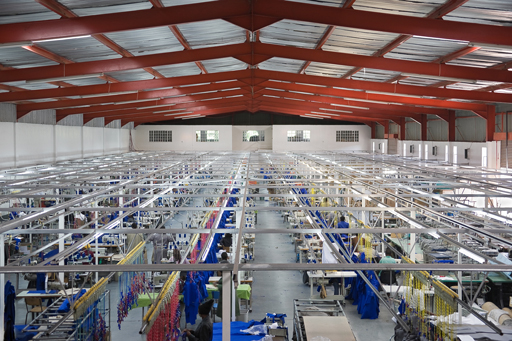
4.3.3 Tanneries
Ethiopia has the largest livestock population of all countries in Africa (TAM Consult, 2008) and tanning of animal hides is an important economic activity. There are 26 major tanneries in Ethiopia (UNIDO, 2012) producing a range of products from sheep, goats and cows including partly processed hides and finished leather (Figure 4.6).
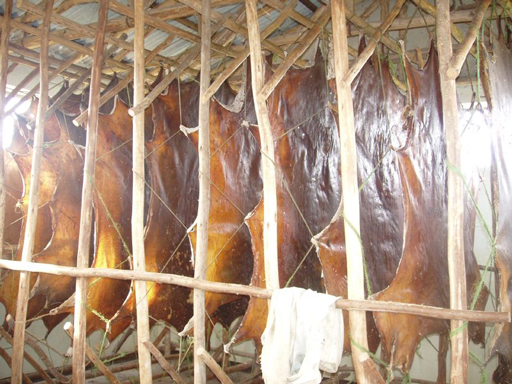
Tannery effluent is highly polluting and is often discharged directly to nearby rivers without adequate treatment. It contains toxic (poisonous) chemicals such as chromium, sulphides and organic acids, as well as organic matter and solids. Chromium is a particular problem because it is an example of a heavy metal. Heavy metals are a group of toxic chemical pollutants that persist in the environment, i.e. they do not get broken down by natural processes. Tannery wastewaters are produced in large volumes and are considerably more polluting than wastewaters from most other industries. The treatment of tannery waste involves removing solids and organic matter from the effluent. These processes are described in Study Session 6.
Summary of Study Session 4
In Study Session 4, you have learned that:
- The composition of liquid waste depends on its source. The three main sources are residential, commercial, and industrial areas. Stormwater is also a source of liquid waste.
- Liquid waste from domestic sources can be classified as blackwater, which contains excreta, and greywater, which does not.
- Liquid waste from commercial areas is broadly similar to wastewater from residential areas. Fats and oil from restaurants and cafes can be removed using a grease trap.
- The characteristics of industrial wastewaters depend on the type of industry. Some industrial wastewaters are hazardous.
- The characteristics of wastewaters can be described in physical, chemical and biological terms.
- Physical characteristics include the amount of suspended solids, the temperature and odour. The amount of suspended solids is measured by filtering a known volume of wastewater and weighing the solids retained on the filter.
- The quantity of organic matter in liquid waste is an important measure of its polluting potential. If discharged into a river or lake, organic matter exerts an oxygen demand which can reduce the availability of oxygen for fish and other aquatic organisms.
- Organic matter is measured in terms of biochemical oxygen demand or chemical oxygen demand.
- Three examples of industries in Ethiopia that produce liquid wastes are food, textiles and tanneries. They each produce polluting liquid wastes that should be treated before being discharged into the environment.
Self-Assessment Questions (SAQs) for Study Session 4
Now that you have completed this study session, you can assess how well you have achieved its Learning Outcomes by answering these questions.
SAQ 4.1 (tests Learning Outcome 4.1)
Rewrite the paragraph below using terms from the list provided to fill the gaps. (Note that some of these terms have been defined in earlier study sessions.)
biochemical oxygen demand, biodegradation, blackwater, chemical oxygen demand, effluent, greywater, hazardous, heavy metals, inorganic, liquid waste, oxygen demand, pathogenic, polluting potential, sewage, sewers, sullage, suspended solids, wastewater.
When we use water for any purpose and it becomes unclean after we used it, we refer to it as ……………… or ……………… In our homes we generate two types of ……………… The type from toilets which contains excreta is called ………………, while other wastewaters (e.g. from clothes washing) that are not contaminated by excreta are referred to as ……………… Another word for the latter type of wastewater is ……………… Domestic wastewater is sometimes referred to as ………………… In many towns and cities around the world domestic wastewater goes into underground pipes called ……………… that take the wastewater to treatment works.
The solids in wastewater that are carried along in flowing water are called ……………… Organic matter in water may cause odours due to ……………… It also creates ………………, which can be measured by its ……………… or ……………… If faecal matter is in the water, there may be ……………… micro-organisms present. ……………… chemicals in wastewaters are likely to include nitrates and phosphates. Industrial wastewaters may have significant ……………… for example, tannery waste frequently contains persistent ……………… pollutants that contain ………………
Answer
When we use water for any purpose and it becomes unclean after we used it, we refer to it as wastewater or effluent. In our homes we generate two types of liquid waste. The type from toilets which contains excreta is called blackwater, while other wastewaters (e.g. from clothes washing) that are not contaminated by excreta are referred to as greywater. Another word for the latter type of wastewater is sullage. Domestic wastewater is sometimes referred to as sewage. In many towns and cities around the world domestic wastewater goes into underground pipes called sewers that take the wastewater to treatment works.
The solids in a wastewater that are carried along in flowing water are called suspended solids. Organic matter in water may cause odours due to biodegradation. It also creates oxygen demand, which can be measured by its biochemical oxygen demand or chemical oxygen demand. If faecal matter is in the water, there may be pathogenic micro-organisms present. Inorganic chemicals in wastewaters are likely to include nitrates and phosphates. Industrial wastewaters may have significant polluting potential, for example, tannery waste frequently contains persistent hazardous pollutants that contain heavy metals.
SAQ 4.2 (tests Learning Outcomes 4.2 and 4.3)
Suggest two ways in which wastewater from residential areas may differ from wastewater from
- a.commercial areas
- b.industrial areas.
Answer
- a.Residential wastewater will probably only contain domestic liquid wastewater but in commercial areas there will also be wastes from businesses such as shops, cafes and restaurants. This may increase the proportion of fats and oils in the effluent.
- b.Both residential and industrial wastewater will contain organic wastes but domestic waste is unlikely to include toxic chemicals, which will be found in many types of industrial waste.
SAQ 4.3 (tests Learning Outcome 4.3)
- a.Worknesh is a laboratory technician. She is analysing a sample of wastewater collected from a pipe that discharges effluent into a river. Name two tests Worknesh could perform to assess the physical characteristics of the effluent.
- b.As part of the analysis she also does a BOD test on the sample and gets an unusually high result. What does the high BOD tell her about the wastewater? What effect could it have on the river?
Answer
- a.To assess the physical characteristics, Worknesh could perform a suspended solids test. She could also measure the temperature of the sample and assess the odour. (Note that if she was measuring temperature she would have to do this at the point of origin because the temperature could change within a short time.)
- b.A high BOD test result would tell Worknesh that there was a lot of organic matter in the sample. If this was discharged into the river it would remove oxygen from the water, which would harm fish and other organisms living in the river.
SAQ 4.4 (tests Learning Outcome 4.4)
Which of the following statements are false? In each case explain why it is incorrect.
- A.Effluent from food processing factories is safe to discharge to rivers without treatment.
- B.The manufacture of clothing material often uses coloured dyes that may be discharged in effluent from the factory.
- C.Tannery waste is highly polluting because it contains large quantities of suspended solids.
- D.Wastewater from slaughterhouses contains blood, animal excreta and washing water.
Answer
A is false. Effluent from food processing factories is not toxic but it will probably contain organic matter, which should be treated before the waste is discharged.
C is false. Tannery waste may contain suspended solids but the reason why it is highly polluting is because it contains toxic chemicals.